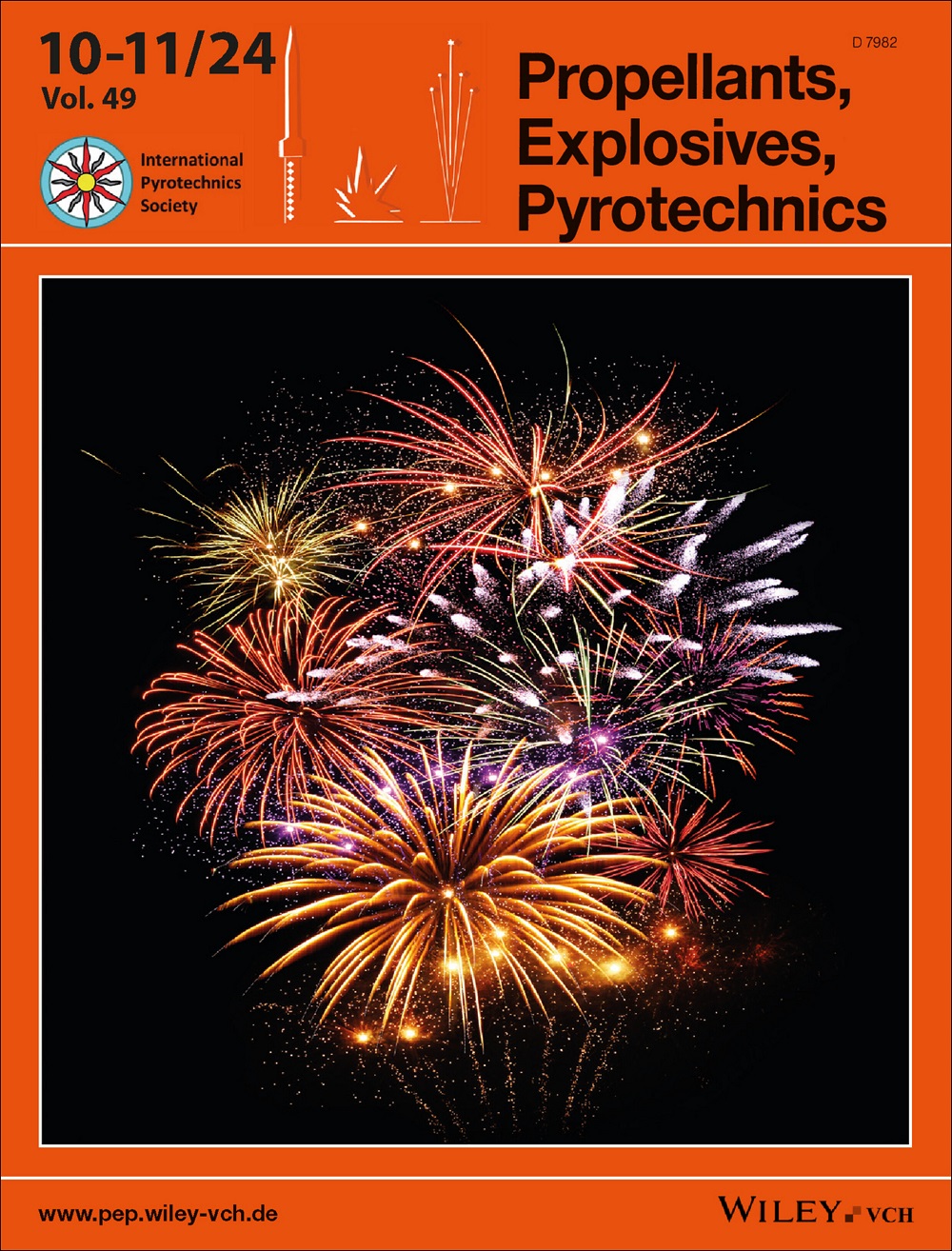利用光纤布拉格光栅技术研究压制 TATB 基聚合物粘合炸药的温度循环应变
IF 2
4区 工程技术
Q3 CHEMISTRY, APPLIED
引用次数: 0
摘要
基于 1,3,5-三氨基-2,4,6-三硝基苯(TATB)的压制聚合物粘合炸药(PBX)在温度循环过程中表现出明显的各向异性和不可逆膨胀特性,导致安全和使用问题。研究表明,PBX 的各向异性和不可逆膨胀特性与微结构(包括炸药晶体、粘结剂、微空隙等)密切相关。光纤布拉格光栅(FBG)技术具有可靠性高、精度高、灵敏度高等优点,更有利于实时捕捉整个温度循环过程中的应变变化。本研究利用 FBG 技术对不同热机械耦合加载条件下压制的 PBX 进行了温度循环应变监测实验研究。在考虑晶体取向、粘合剂和孔隙率等潜在微结构因素的情况下,测量并分析了压制参数对 PBX 在温度循环过程中各向异性和不可逆膨胀特性的影响。结果表明,PBX 圆柱体侧面和顶部的应变随着应变的增加向密度较大的方向分布。在温度循环的高温阶段,应变分层明显,而在低温阶段则不明显。应变分层的程度随着温度循环周期的增加而降低,并随着压制温度的升高而增加。在循环过程中,PBX 缸体的各向异性膨胀随着温度的升高而增加,随着温度的降低而减少。在温度循环的后期循环中,在不同压缩条件下压制的 PBX 圆柱的轴向膨胀程度与其内部不同的晶体取向强度相一致。本文章由计算机程序翻译,如有差异,请以英文原文为准。
Using a fiber Bragg grating technique to investigate temperature cycling strain of pressed TATB‐based polymer‐bonded explosives
Pressed 1,3,5‐triamino‐2,4,6‐trinitrobenzene (TATB)‐based polymer‐bonded explosive (PBX) exhibits significant anisotropic and irreversible expansion characteristics during temperature cycling, resulting in both safety and service issues. The anisotropic and irreversible expansion properties of PBX have shown to be closely related to the microstructures, including explosive crystals, binders, micro voids, el. Fiber Bragg grating (FBG) technology has advantages of high reliability, accuracy, and sensitivity, which is more conducive to real‐time capture of the changes in strain throughout the temperature cycling. In this study, temperature cycling strain monitoring experiments of PBX pressed under different thermal–mechanical coupling loading conditions were studied using FBG technology. The effect of the pressing parameters on the anisotropic and irreversible expansion characteristics of the PBX's during temperature cycling was measured and analyzed, taking into account potential microstructural factors such as crystal orientation, binders, and porosity. The results indicated that the strain on the side and top of PBX cylinders were distributed with increasing strain in the direction of higher density. The strain stratification was significant during the high‐temperature stage of temperature cycling and was not obvious during the low‐temperature stage. The degree of strain stratification decreased with an increase in temperature cycling cycles and increased with higher pressing temperatures. The anisotropic expansion of PBX cylinders increased with an increase in temperature during cycling and decreased with a reduction in temperature. The axial expansion degree of PBX cylinders pressed under different compression conditions in the later cycles of temperature cycling is consistent with the different crystal orientations intensity inside them.
求助全文
通过发布文献求助,成功后即可免费获取论文全文。
去求助
来源期刊

Propellants, Explosives, Pyrotechnics
工程技术-工程:化工
CiteScore
4.20
自引率
16.70%
发文量
235
审稿时长
2.7 months
期刊介绍:
Propellants, Explosives, Pyrotechnics (PEP) is an international, peer-reviewed journal containing Full Papers, Short Communications, critical Reviews, as well as details of forthcoming meetings and book reviews concerned with the research, development and production in relation to propellants, explosives, and pyrotechnics for all applications. Being the official journal of the International Pyrotechnics Society, PEP is a vital medium and the state-of-the-art forum for the exchange of science and technology in energetic materials. PEP is published 12 times a year.
PEP is devoted to advancing the science, technology and engineering elements in the storage and manipulation of chemical energy, specifically in propellants, explosives and pyrotechnics. Articles should provide scientific context, articulate impact, and be generally applicable to the energetic materials and wider scientific community. PEP is not a defense journal and does not feature the weaponization of materials and related systems or include information that would aid in the development or utilization of improvised explosive systems, e.g., synthesis routes to terrorist explosives.
 求助内容:
求助内容: 应助结果提醒方式:
应助结果提醒方式:


